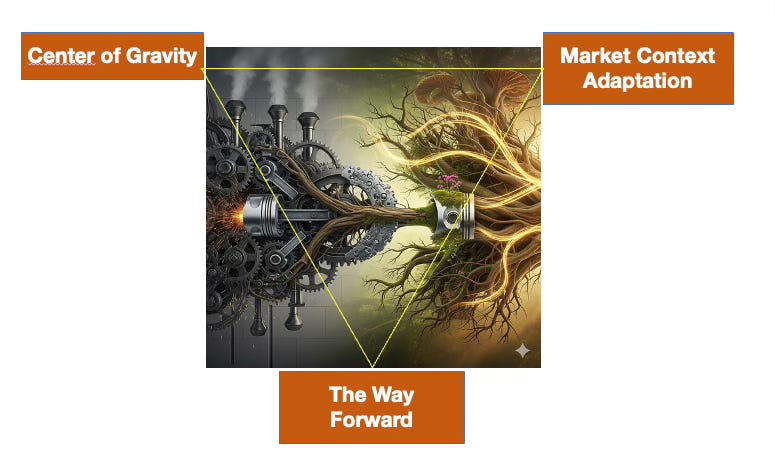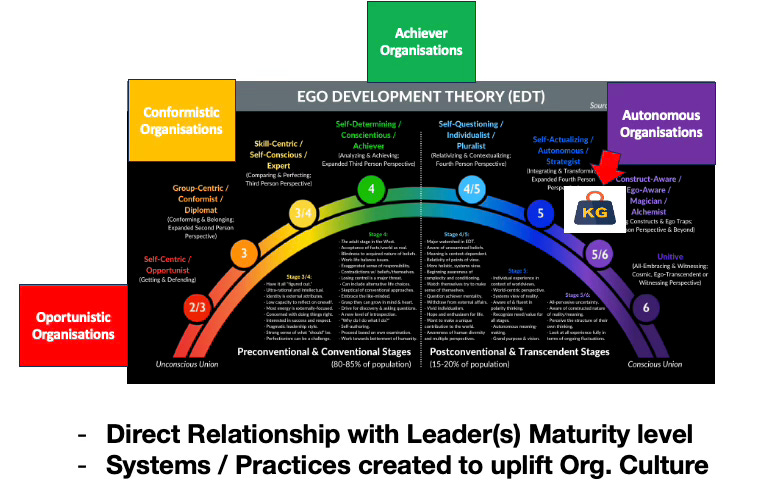The Threshold of Aliveness
Every organisation begins as an idea, becomes a structure, and eventually — if it is awake enough — turns into a living being. Most never cross that threshold. They remain clever machines, beautifully engineered, running on strategy, metrics, and control. But a few make the leap: they acquire consciousness, a felt sense of self, and an ability to sense and adapt like life itself.
To understand what makes this possible, we must look at the center of gravity of the organisation — the level of maturity, belief, and awareness that anchors its collective behaviour. This center of gravity decides how an organisation responds to uncertainty, how it treats people, and how it interprets its purpose in the wider world.
The Evolution of Organisational Being
An organisation’s evolution mirrors the development of human consciousness.
The Opportunistic phase: survival, reaction, control.
The Conformistic phase: order, procedure, belonging.
The Achiever phase: performance, progress, competition.
The Autonomous phase: purpose, systems thinking, reflection.
The Post-Autonomous phase: consciousness of consciousness itself — the ability to witness and renew.
At this last threshold, the organisation stops identifying with its form and begins identifying with its flow. It recognises that stability comes not from rigidity but from rhythm.
From Mechanistic to Living Systems
Traditional management sees an organisation as a machine: inputs, outputs, KPIs, hierarchies. The Alive perspective sees it as a living organism: metabolism, relationships, adaptation, purpose.
In a mechanistic paradigm, change is managed. In a living paradigm, change is breathed.
Machines break when stressed. Organisms evolve.
The difference is not merely metaphorical — it is ontological. A living system self-organises; it learns through feedback; it regenerates itself from within.
Alive Organisations therefore build structures that behave more like ecosystems than factories: they balance autonomy and coherence, exploration and exploitation, diversity and unity.
The Core Characteristics of an Alive Organisation
Four inter-related characteristics define aliveness:
Wholeness — People show up as entire beings: rational, emotional, intuitive, spiritual. Work becomes a practice of authenticity.
Co-Creation of Value — The organisation exists to create value for the upper level - society, market, planet.
Purpose in Motion — Purpose is not a plaque on the wall; it is a dynamic question. The organisation listens to its environment and to itself. It responds not only to metrics but to meaning.
Self-Evolving Structure — Roles, teams, and boundaries shift organically, guided by function and energy, not by fixed hierarchy.
These four mirror the Pillars of Aliveness explored in Part II — Whole Being, Value Co-Creation, Alive Purpose, and Metamorphic Structure.
The Role of Market Context
A living organism is always in dialogue with its environment. Likewise, an Alive Organisation understands that context is co-creator.
It reads the market not as an adversary but as an ecosystem — a field of mutual adaptation. Customer needs, technological change, and societal shifts are not “external pressures” but signals of evolution. Thus, strategy becomes ecology: sensing where business wants to move next and partnering with that movement.
When market turbulence increases, the mechanistic organisation tightens control; the alive organisation deepens awareness. It trusts that clarity arises from presence, not prediction.
The Center of Gravity
Every organisation has developmental strata (maturity bubbles) within it — some teams live in Achiever logic, others in Conformist comfort, a few in Autonomous awareness. Yet overall, there exists a center of gravity — the prevailing developmental altitude that defines the organisation’s default response.
This center of gravity is not fixed. It can rise through intentional developmental work, or fall under fear and pressure. Transformation therefore begins not by copying new structures but by raising consciousness: what the system notices, values, and believes about the world. As this center of gravity shifts upward, the organisation’s culture, strategy, and leadership naturally re-configure to match. No external “change management” is required; aliveness does the work.
The Four Realities of Aliveness
From all perspectives studied — biological, psychological, and organisational — aliveness expresses itself through four intertwined realities:
Inner Awareness – the subjective dimension (beliefs, consciousness).
Relational Energy – the collaborative dimension (trust, belonging, conversation) when creating value.
Behavioural Expression – the practical dimension (action, learning, feedback).
Structural Form – the systemic dimension (roles, processes, governance).
When these four realities are aligned and mutually reinforcing, vitality flows. When they fragment, energy leaks and the system decays.
Alive Organisations therefore practice continuous alignment — the art of keeping the inner, relational, behavioural, and structural dimensions coherent with purpose.
The Shift from Self-Protection to Self-Fulfilment
At the deepest level, an organisation’s evolution is a journey from self-protection to self-fulfilment.
Self-protecting organisations invest their intelligence in defence: guarding turf, managing image, avoiding blame.
Self-fulfilling organisations invest their intelligence in creation: discovering meaning, nurturing growth, expanding possibility.
The outer difference is subtle — both can be busy, productive, and profitable — but the inner texture is worlds apart. In one, energy contracts; in the other, it expands.
The transition from protection to fulfilment is the moment of awakening — when an organisation realises that its true purpose is not survival but contribution.
Aliveness as Practice
To be alive is not a static condition but a continual practice: sensing, learning, integrating, renewing. An Alive Organisation continually asks:
What are we noticing that we used to ignore?
What beliefs are shaping our actions now?
Where is life inviting us to grow next?
These questions become the heartbeat of the system. They keep the organisation from falling back into mechanistic sleep.
A Living Definition
An Alive Organisation is a conscious, adaptive system in which people, purpose, and structure evolve together in mutual awareness, creating value that nourishes both the organisation and the wider field of life.
It is a system that learns faster than its environment, not because it controls more data, but because it listens more deeply.
It is guided not by fear of failure but by fascination with emergence.
It thrives on connection, meaning, and contribution.
In short, it behaves like life itself.
Transition to Part II
With this understanding, we are prepared for next part of Alive Organisations paradigm. The next part explores the four Pillars of Aliveness in depth — how each translates belief and consciousness into tangible organisational practice:
Whole Being — reclaiming humanity.
Value Co-Creation — transforming exchange into contribution.
Alive Purpose — turning mission into living dialogue.
Metamorphic Structure — designing for continuous evolution.
Together they form the architecture through which aliveness becomes not an ideal but a lived organisational reality.
Enjoy reading and applying these content. If you’d like to receive additional information regarding Alive Organisations topic please subscribe below.




